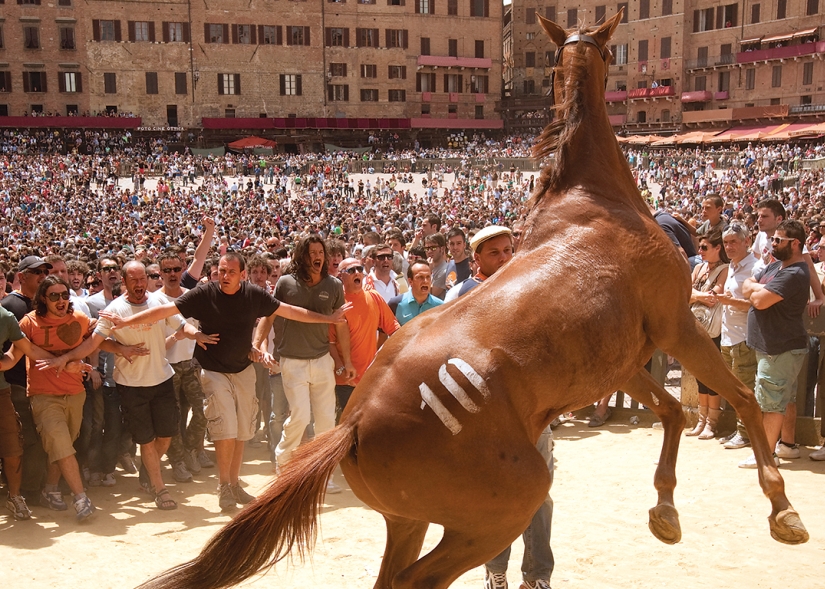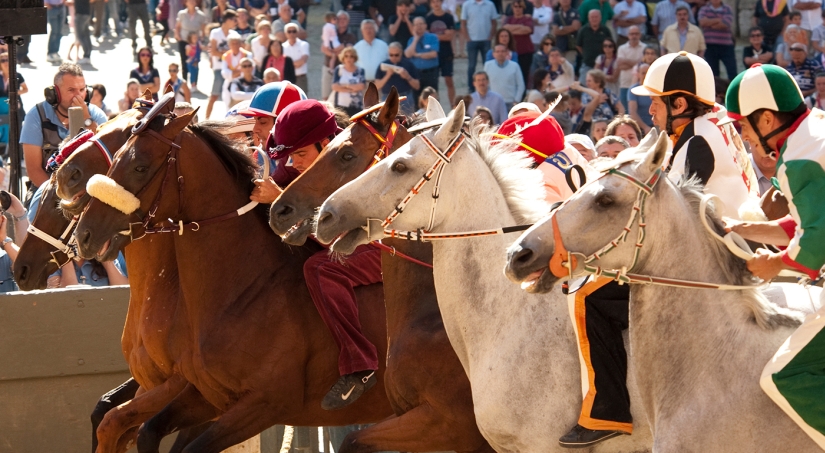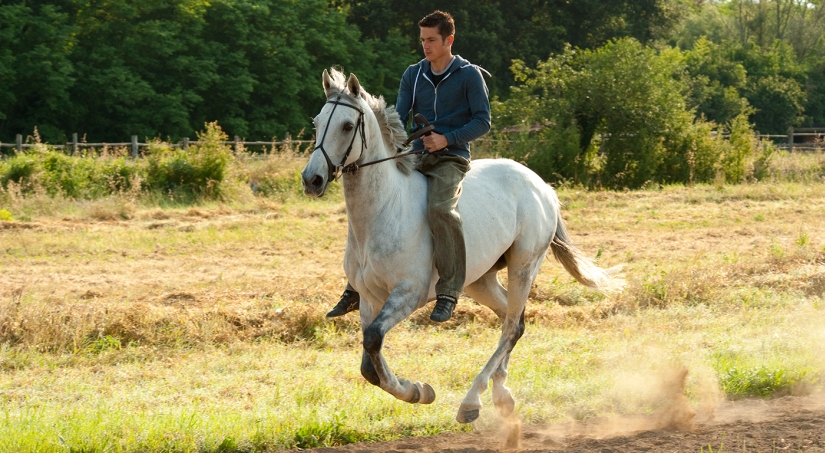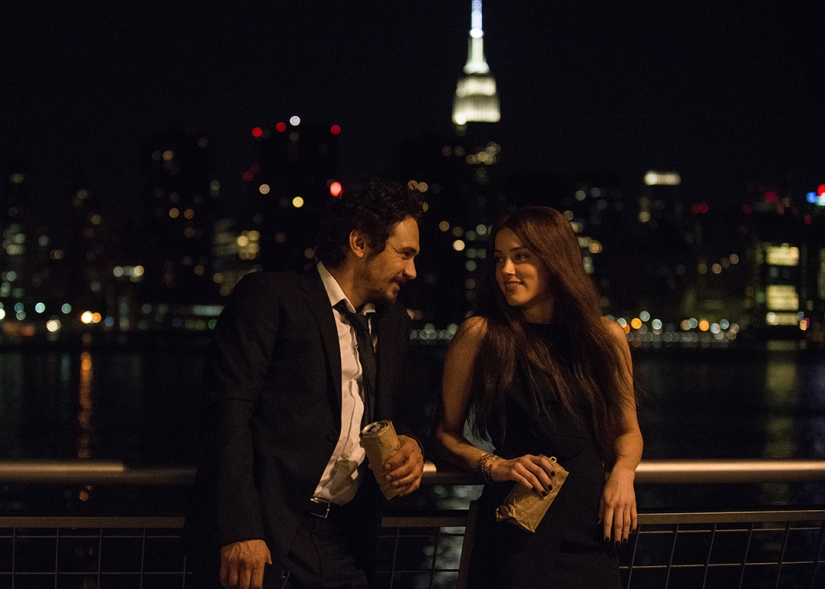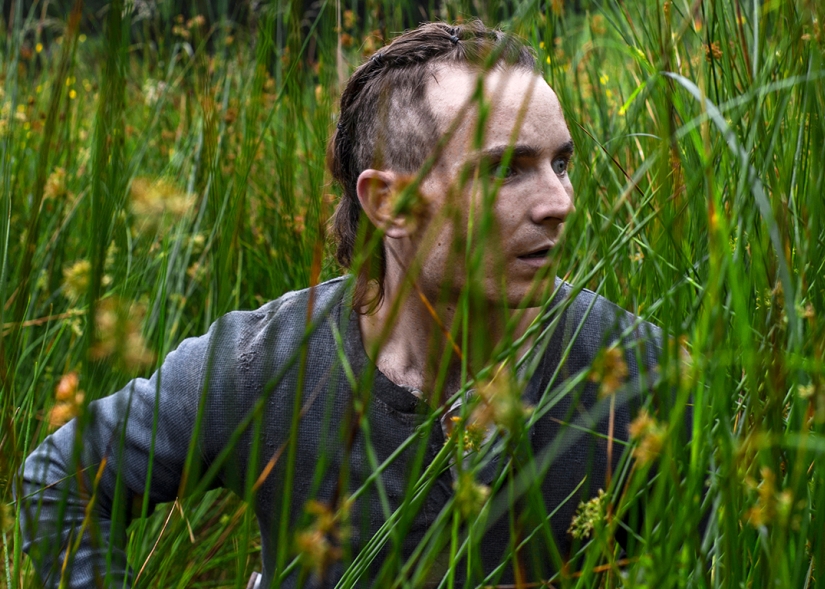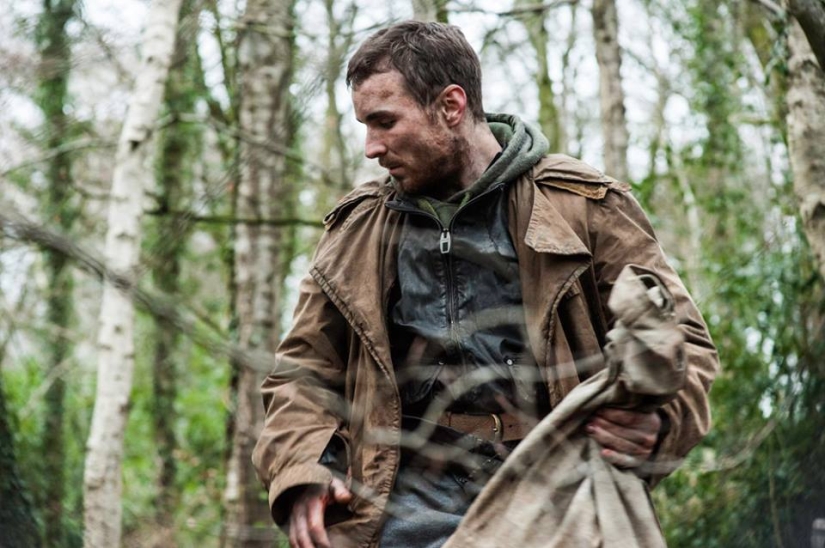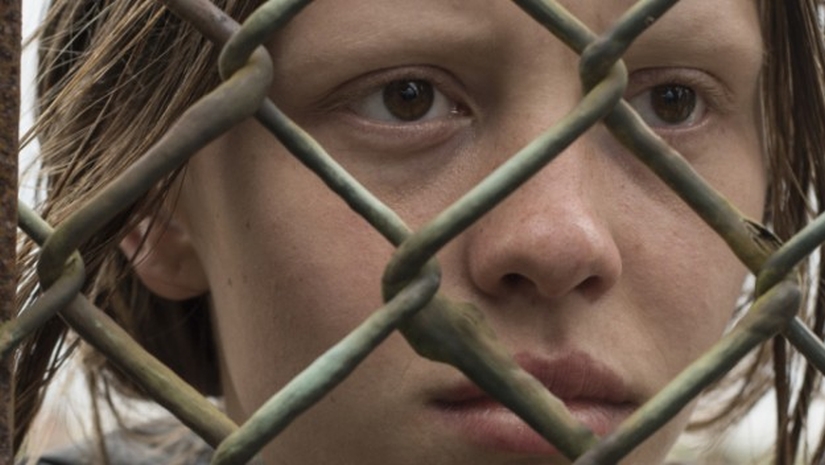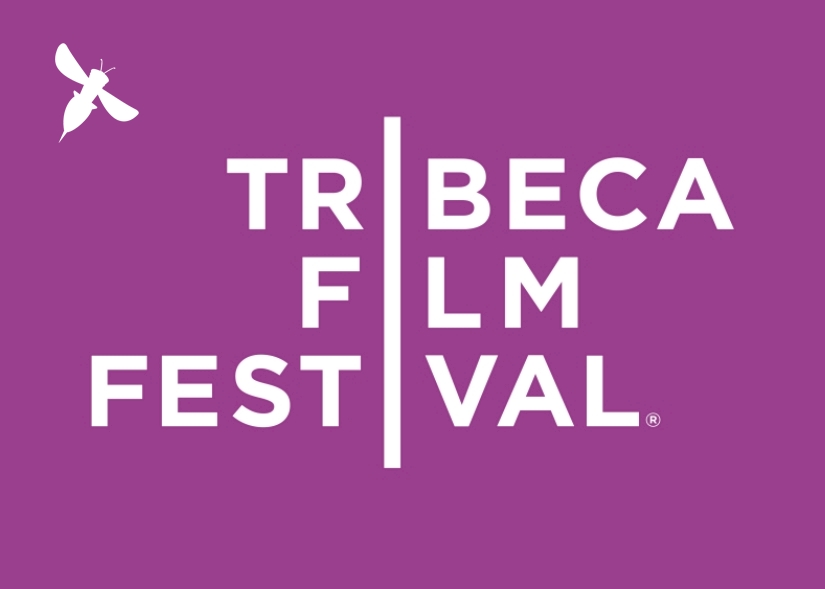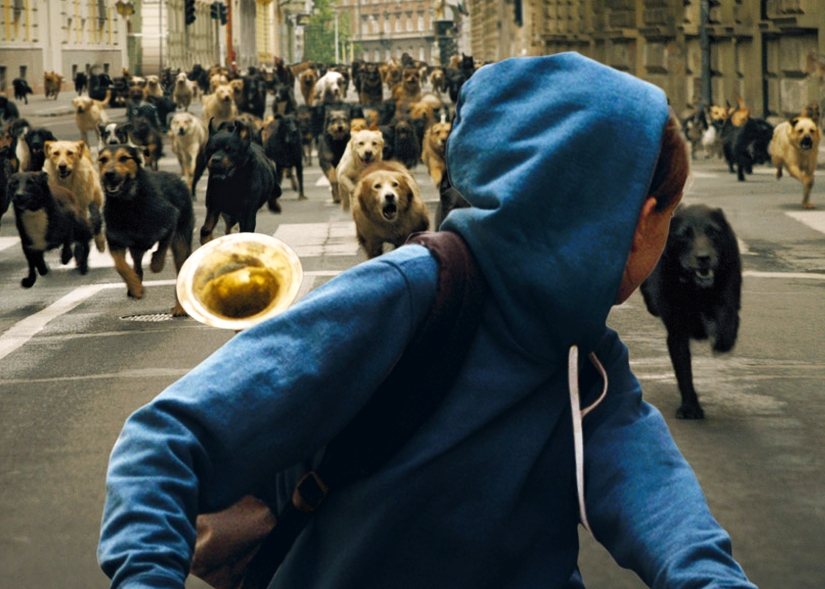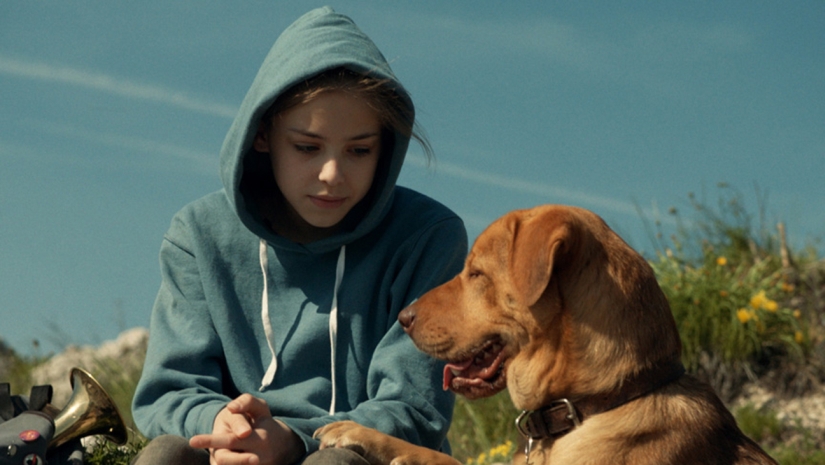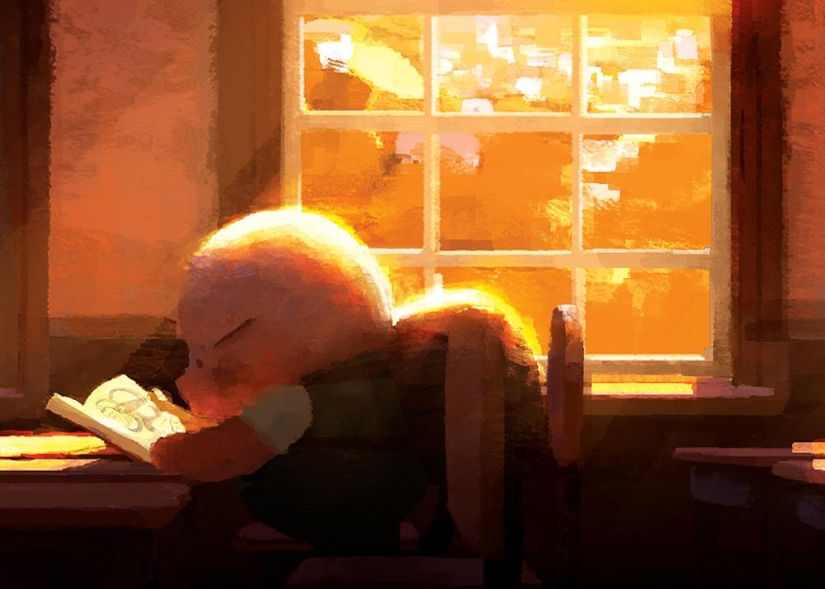[Tribeca Review] Palio
The Palio is a horse race that's been held in the Italian city of Siena since 1656. Twice each year in the summer, the 14 districts of the city pick horses and hire jockeys to represent them. The riders dash around the square for 90 mad seconds while the crowds watching from the ground and the windows cheer them on. Some horses skid into walls during a sloped right-angle turn, others slip and tumble and bring bodies down with them in a pile. Only first place matters.
And the race is just part of the intrigue.
Palio is a documentary shot and edited with the verve of a narrative thriller. It's exhilarating, it's exhausting; spiked everywhere with ancient history, colorful local yarns, and the myths of conquering heroes. Director Cosima Spender has crafted a sports movie by way of Spaghetti westerns, and yet it's so much more. There are multiple surprises nested in this Sienese tradition, and there's rarely if ever a lull in the action.
Palio
Director: Cosima Spender
Rating: N/A
Release Date: April 18, 2015 (Tribeca)
The primary focus of Palio isn't the personality of the districts but rather the men who ride the races. The jockeys have no allegiance to anyone but themselves, we're told. Many are out-of-towners. They're mercenaries working for the highest bidder, and they're hired to ride a horse that's picked in a draft process rather than a horse they might have worked with in the off-season. There's a love/hate relationship between the jockeys and the people. When a jockey wins a race, they are glorified. When a jockey loses, crowds get crazy. Spender shares archival footage of a losing Palio jockey pulled to the ground, dragged, and absolutely brutalized by rabid spectators.
Jockey Andrea Degortes, nicknamed Aceto, won 14 Palios from 1965 to 1992. He's a larger-than-life figure, all machismo and swagger for the brief moments of screentime he has. Yet despite victories, he recounts on camera a single loss that caused him to go into hiding. He legitimately feared for his life.
There's a tale of generations in Palio. Gigi Bruschelli is one of the more dominant jockeys in action. He's won 12 Palios and wants to tie and unseat Aceto's record while he's still able. (Though if you ask Aceto, Bruschelli's only won 11.) There's also a younger jockey, Giovanni Atzeni, whose promise seems limitless. The older jockeys and fans swap stories, and they still have the same arguments they had in the past. Each subject we spend time with is involving in their own way.
There's also a tale of backroom drama in Palio, and it's presented with a sense of conspiracy. Spender catches implications of bribes and other shady dealings for strategic advantage. District rivalries are played against each other, last-second deals might be cut at the crucial point before a race starts. When asked about some of his more questionable methods, Bruschelli smiles like a good mercenary to deflect and conceal.
Palio is constructed so viewers can experience the strange beauty of ritual. While we don't get the full scope of the pageantry, we hear the district names called out—unicorn, giraffe, she-wolf, tower, wave, seashell. The districts wear their colors and sing their songs. The hooves rumble and thunder thanks to the expert sound design. We watch jockeys hoisted in the air as a swell of an Ennio Morricone score elevates the rider to the state of gunslinger, warrior, gladiator. We even catch a glimpse of a special contraption that picks the starting line order at random. Spender presents the object with equal parts majesty and mystery so that the inner mechanisms at play retain their potential for magic.
These rules and these images are like something out of an Italo Calvino story, so charming, so fascinating, such a feast of ideas. And like a Calvino story, I can't wait to revisit Palio for its craft and the excitement it inspires.
For more information on Palio and to find out about screenings/tickets for the Tribeca Film Festival, click here.
[Tribeca] The Adderall Diaries and the Problem with the Brilliant Male Writer Cliche
I think it was Harlan Ellison who said that most people believe they're a better writer and a better fuck than everyone else. That succinctly describes the absurd narcissism at the heart of the male writer trope: he's ruggedly masculine and yet aesthetically sensitive, he's smart in a way that's worldly rather than academic—brilliant, really—he constantly struggles with writer's block until a divine spark of inspiration leads to the rapid production of undeniable genius, and everyone wants to have sex with him because he's really good at it—no, the best, actually.
The brilliant male writer cliche is ridiculous yet persistent, and these tropes make the adaptation of The Adderall Diaries starring James Franco feel so uninspired. I haven't read Stephen Elliott's memoir of the same name, though excerpts from the book strike such a different tone from the film. It's not just because the story's been moved from San Francisco to New York. While the source material seems like a genuine exploration of strained father-son relationships and the ways people remember and misremember, writer/director Pamela Romanowsky's movie comes across as sycophantic genuflection to the idea of the brilliant male writer.
[Tribeca Review] The Survivalist
In most post-apocalyptic movies, the predominant colors are brown and gray, as if the only things that can exist in this fallen world are dirt, soot, and some muddy combination of the two. In Stephen Fingleton's assured feature film debut, The Survivalist, the post-apocalytic world is green instead, lush and overgrown now that the human population is too low to mess it up. Yet like Werner Herzog said about the anarchy of the jungle, this kind of wildness is cruel, and everywhere it's full of murder and death.
The world of The Survivalist isn't just overgrown, though. It's quiet out there, and in that sinister, a-little-too-quiet way. Our title character (Martin McCann) lives on his own in the wilderness in a sustainable cabin for one. Think Henry David Thoreau's Walden, but with the occasional raiding band of cannibal scavengers.
The Survivalist
Director: Stephen Fingleton
Rating: N/A
Release Date: April 16, 2015 (Tribeca)
The survivalist doesn't say a word as he goes about a series of routines: he buries a body, he chops firewood, he plants vegetables, he makes lantern oil, he jerks off. When a mother and daughter (Olwen Fouere and Mia Goth) arrive asking for food, there's finally some dialogue. They look like a pair of backpackers, but their mere presence is menacing. What the two women are asking for may not match their motives, and the survivalist's intentions may not be so pure either. The way they negotiate suggests that this is how the world works now: all interpersonal interactions are types of transactions (even sex) carried out with quiet suspicion.
The lack of dialogue in The Survivalist is so full of potential meaning and scheming thanks to the grim look of the cast, and Fingleton finds surprising power in his expert control of images and silences. The control is apparent with his clever presentation of a graph that opens the film. A red line courses along a black screen representing the increase of human population since the middle ages. A blue line appears representing oil production, and the two lines rise together, abandoning specific decades and centuries. Eventually the blue line dips from view, and we follow the red line as it changes its orientation on the screen into decline.
That's the history of a post-apocalyptic world told in two phrases, a handful of numbers, two lines, and the illusion of motion.
When one of the characters is in danger, a crane shot moves over a field of tall grass with controlled purpose—like the rise and fall of the infographic line, like the dread of a drawn-out note on violins. The audience sees the danger in the field that our hero can't see, and the audience also knows something about the situation that our hero doesn't realize.
The Survivalist takes advantage of the limitations in a character's knowledge. It enhances a number of tense moments throughout the film, where a brief beam of light in the dark is a herald of doom, or even the way a character selects and holds a garden tool seems like a prelude to murder. Everything and everyone is so on edge because the world is out to get them. The Survivalist is all about the pervasive suspense of the quiet and unseen world, and also the unknown and unspoken aims of other people.
Fingleton's visual panache drives most of the film's mood, though the grounded performances lend subdued desperation to the proceedings. McCann has a feral kill-or-be-killed edge, and Fouere has a fox-like mien that suggest she's always calculating her next move; Goth seems so withdrawn, by contrast, and it's difficult to tell what her character's feeling or if she feels much at all anymore. That's the reality of the world of The Survivalist, though there's something harsher that all the characters have come to accept: even small changes in routine can mean the difference between life and death.
For more information on The Survivalist and to find out about screenings/tickets for the Tribeca Film Festival, click here.
The 2015 Tribeca Film Festival Begins
The 2015 Tribeca Film Festival kicks off tonight in New York City. Established in 2002, this year's Tribeca Film Festival runs from April 15th to the 26th, and features numerous world premieres, special screenings and events, talks and conversations with filmmakers, arts installations, and more.
Some notable programming includes a conversation between George Lucas and Stephen Colbert, a Q&A with the cast and crew of GoodFellas moderated by Jon Stewart, a 40th anniversary screening of Monty Python and the Holy Grail with surviving Python members in attendance, and much more.
During the next two weeks, you'll find reviews and other kinds of coverage here at Ruby Hornet. Our first reviews will be hitting on Friday.
For tickets and more information about the Tribeca Film Festival, visit their website.
WrestleMania 31: Results and Match Reviews
As noted in our WrestleMania 31 preview, the build to this year's big event was lackluster at best. Stories weren't told well, heat and interest for most of the matches was poor, and the main event between Brock Lesnar and Roman Reigns had a potential to turn into an ugly disaster.
Yet WrestleMania 31 delivered for the most part, and had some surprisingly entertaining segments and guest appearances. The finish to the main event was a great swerve as well, and something that wrestling fans will be talking about for a while.
(The less said about the Kid Ink, Skylar Grey, and Travis Barker performance the better, though. I feel bad for them performing for an apathetic crowd of 76,976* that just wanted to watch some hypermasculine theater and stage combat.)
Let's go through WrestleMania 31 match-by-match and give the full card a rundown.
*That's the WWE's attendance count, so it's probably inflated by at least 6,000
White God
Audacity is the primary strength of White God, Hungarian director Kornél Mundruczó's political parable about a revolt of dogs against humanity, which is why the film opens with such a striking series of images: the stillness of an empty Budapest, a girl on a bike being chased by hundreds of strays. The wall of teeth and fur inspires a sense of horrified awe. It's a nightmare; something out 28 Days Later and a nature-run-amok movie (e.g., The Birds).
The film then flashes back to show how we came to that point. The technique is structurally off-putting to me whenever it's used, but Mundruczó understands the power and importance of those images. Not only are they striking (White God's marketing is built on these shots of canine revolution), they're the heart of the film. That's why as White God progressed, it felt as if the potency of that opening scene was diluted.
For that, we have the humans to blame.
[iframe id="https://www.youtube.com/embed/kIGz2kyo26U" align="center" mode="normal" autoplay="no" maxwidth="825"]
White God (Fehér isten)
Director: Kornél Mundruczó
Rating: R
Release Date: March 27, 2015
The dog that leads the eventual stray uprising is Hagen (played by two dogs, siblings, Bodie and Luke). He belongs to 13-year-old Lili (Zsofia Psotta), the daughter of divorced parents who must go stay with her father (Sandor Zsoter) for a while. In her father's building, residents who have mixed-breed dogs have to pay a tax, which leads to Hagen getting left on the side of the road to fend for himself.
The sequences with Hagen are fantastic and exhibit some of the best canine acting since Samuel Fuller's White Dog, which used the reformation of an attack dog to explore racism as a learned behavior. (Coincidentally, one of the dog handlers on White God is the daughter of the handler from White Dog.) On his first day alone, Hagen ponders the corpse of another stray, pawing at it as if trying to stir the dog awake. He fails and ruminates in a way that's all too human. Recognition dawns in his dark yet contemplative eyes, in the arch of his spine, in the angle of his ears and forepaws. Hagen's journey is a rough one, leading him from one abusive master to the next, sold and traded and devalued with each subsequent transaction.
So much can be read into Hagen's story. His first day or so is handled like a recreation of the immigrant experience, unmoored, startled by a new world, ushered into unfamiliar rules and customs. One smaller stray acts as a kind of guide for Hagen, showing him where other strays congregate and the harshness of animal control. When Hagen goes from master to master, the imagery recalls narratives of sexual slavery, sweat shop work, underground fights, and prisons. Mundruczó's done such smart work to anthropomorphize the dogs and the situations. Rather than narrow focus to a specific kind of victimization, a multitude of human miseries can be read into these situations. The dogs function as the embodiment of the downtrodden in general—the poor, the weak, the disenfranchised, the undocumented, the discarded—and the world is merciless to them.
Hagen's story is more than enough to carry White God as a film. Yet Mundruczó continually cuts back to a less engaging domestic drama and coming-of-age tale involving Lili and her father. The human stuff all seems rote rather than lived in, and marks a strange tonal shift from the raw, high-stakes political observations on Hagen's side of the story. Lili and Hagen felt more perpendicular than parallel, and almost every time White God cut back to the humans, I felt less engaged with the film. It's as if the master class held their pets back.
There's also an issue of the last third of White God, which marks another major shift in tone and focus. By then we've returned to the dog uprising shown at the beginning, and the film begins to feel less like The Birds and more like The Birds II: Land's End. The political dimension is still there and the imagery recalls, briefly, the London Riots and The Arab Spring, but it feels like the film has gone from a parable to a horror movie. Mundruczó even has a kind of slasher movie vibe in a few of the dog attacks on their human oppressors.
White God is a fascinating watch and ultimately aims high even though it's all over the place. Yet like some movies in which certain parts hit me harder than others, I'm left thinking about the film conterfactually—many "what if's" that outweigh what's there. Mainly, I wanted more of that sense of anarchy hinted in the opening scenes; more meat for the metaphor, less restraint of the beasts. The revolution will not be sentimentalized (at least not totally), but maybe it was just a little bit anesthetized.
WrestleMania 31: Final Card Preview and Match Predictions
WrestleMania 31 happens this Sunday at Levi's Stadium in Santa Clara, California. Unfortunately, this might be the least exciting build to a WrestleMania in a long time. The storytelling has been pretty boring, and the main event pitting WWE Champion Brock Lesnar against the company's hand-selected challenger Roman Reigns will likely underwhelm.
But it's only $10 via the WWE Network, so you'll buy it and watch it.
Yes, the showcase of the immortals is now cheaper than a six-pack of your favorite craft brew. And it sure feels like it.
This is a real shame given the amount of talent on the roster that's being squandered or underutilized. Still, there are some solid matches on the card, including the ladder match for the Intercontinental belt, the return of The Undertaker, and the WWE in-ring debut of Sting.
Here's a full rundown of the WrestleMania 31 card as well as some of my predictions on who will win.
The Dam Keeper Has a Second Life: On the Animated Short That Should Have Won an Oscar
It was announced last week that the Oscar-nominated animated short The Dam Keeper will be expanding into a feature film as well as two graphic novels. This was great news given that it's been a few weeks since The 87th Academy Awards and I was afraid that The Dam Keeper might get forgotten. That's the fate of so many short films at The Oscars, but The Dam Keeper, directed by Robert Kondo and Dice Tsutsumi, is a remarkably poignant and unforgettable film.
This isn't to say that Disney's Feast, which won the Oscar for Best Animated Short, isn't good. It's cute and quaintly done, yet Feast is familiar to a fault—kind of like the beginning of Up but not as emotionally full or earned; climaxing sort of like the Disney short Paperman, but with a dog and parsley instead of paper airplanes and lipstick. The Dam Keeper looks and feels like the start of something new—the first yawp from the studio Tonko House—and it risks more in its 18-minute run time because of what it's trying to say about being a better human being.
You can buy The Dam Keeper on Amazon, iTunes, and Vimeo and view it for yourself, but I'd like to offer a brief appreciation of the film.
[iframe id="https://www.youtube.com/embed/eAidtk0GpUQ" align="center" mode="normal" autoplay="no" maxwidth="825"]
The Dam Keeper centers on the life of an orphaned pig who works inside of a giant fan at the edge of town atop a dam. He has to crank and set the fan regularly in order to keep a poisonous smog away. He's isolated and bullied at school (he's the archetype of the big kid, the quiet kid, the different kid that you knew or might have been), but he finds a friend in a fox. By the end, The Dam Keeper winds up being an exploration of loneliness, friendship, the absurdities of bullying, how people deal with depression, and, at least to me, our fundamental moral obligations to others.
The whole film looks like a picture book come to life, a world built out of paint. This is all thanks to the animation style, which eschews computer animation and was primarily hand-painted instead. The Dam Keeper consists of more than 8,000 individual paintings, with so many organic strokes built into the movements of the characters and the backgrounds. The animators had to spend time learning to draw in the same style, painting together to ensure a consistent look to the film.
Whether intentional or not, this act of collective and obsessive labor seems to be referenced in one of The Dam Keeper's memorable moments: as the pig and the fox draw together, the real world blurs into something diaphanous, like air and like water, and there's only laughter and the joy of connection and the careless play of making art.
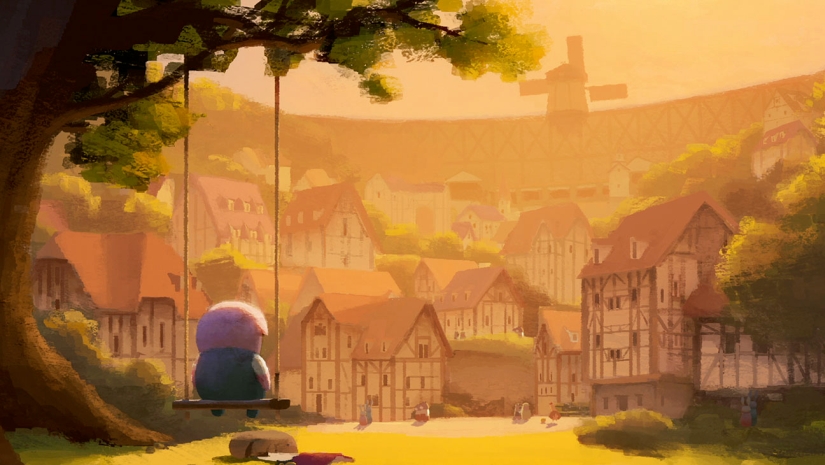
There's a similar care with The Dam Keeper's score by Zach Johnston and Matteo Roberts, which is sort of like a blend of Jon Brion (Paranorman) and Joe Hisaishi (the films of Hayao Miyazaki). Throughout, the score serves as an emotional scaffold. There's a childlike sense about it, as if profound emotions are contained in the music and the melody is there to convey what language can't process.
The Dam Keeper had a peculiar way of sneaking up on me, and feeling personal even though it was about a pig and a fox. There's something to be said about the successful use of animals as human analogs. They're blank and unparticularized as actual people per se, which allows viewers to read their own lives or experiences into the existence of something non-human. We're forced to think "When did I feel like that?" or "When did someone I care about feel something like that?" This is one of those subtle and necessary exercises of empathy unique to good metaphors and fitting analogs.
There are unexpectedly moving moments of The Dam Keeper that stick with me weeks later, and I think they work because of this exercise of empathy. Grounding the film in reality rather than animals and the fantastical conceit would have undermined the power of the story. Metaphors can often be more powerful than reality. Sometimes the reality of our emotional lives requires the framework of fantasy, fable, or fairy tales to be revealed to us, and The Dam Keeper does this essential, humanizing work beautifully.

